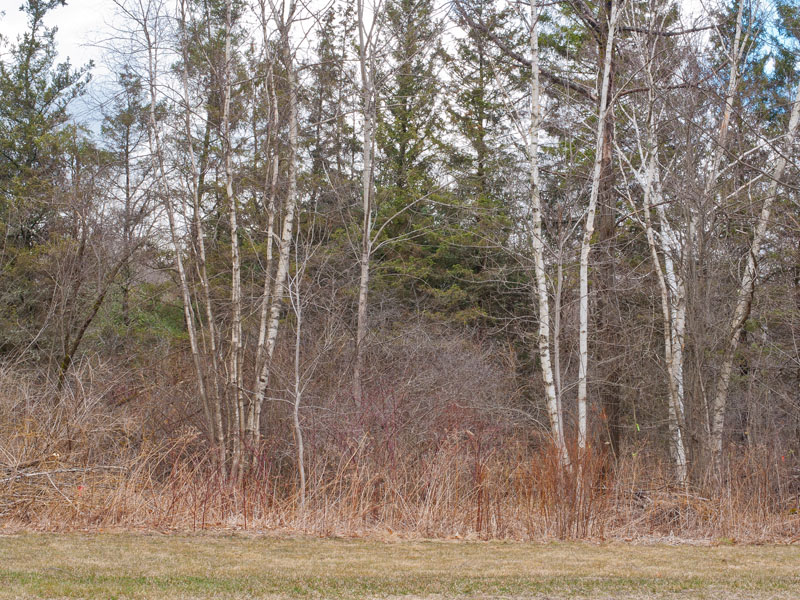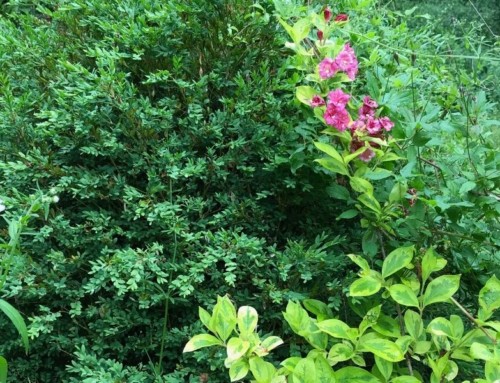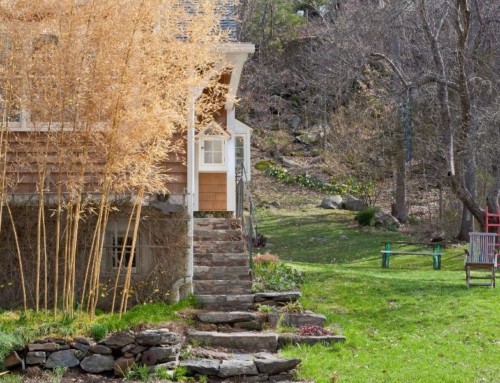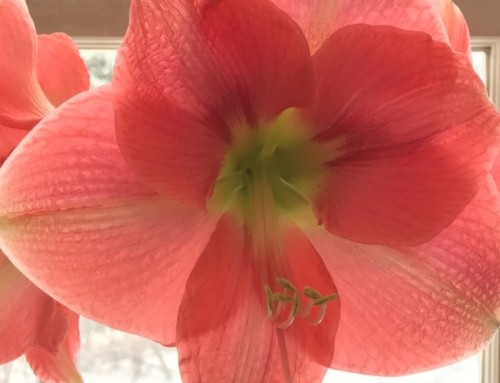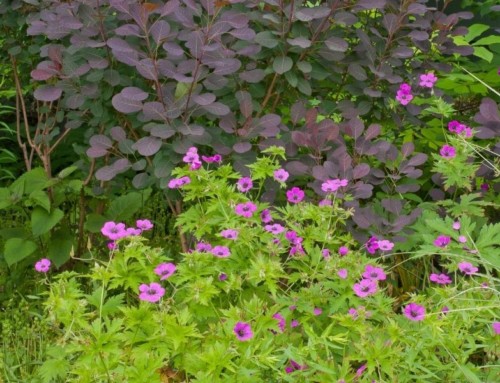Early this March, Nancy, a long-time garden coaching client, asked me to look at the patch of storm-damaged woods behind her house. She wanted me to identify plants and develop a strategy for editing and managing it as a natural area for wildlife and contemplative meandering.
We were both all too familiar with the woody invasive plants back there (See How to Get the Jump on Invasive Shrubs). She had already cut or tagged many for removal, a seemingly endless task.
You can’t fix the problem by digging out all the invasive plants, disturbing soil and walking away. That just invites more invasive plants. We wanted to mend this little backyard habitat by filling every niche with a diverse community of well-adapted wildlife-supporting native plants.
What was already there to preserve, protect and encourage to spread? What could existing plants tell us about the site and other possible plant choices?
Thorns and thickets, tangled woody invasives, lots of broken and half-dead trees and eye-poking twigs made for slow, careful walking that chilly damp day.
We intrepid sleuths found plenty of clues in the leafless woods. The plants we could identify helped us understand what else was inclined to grow there.
Reading the Clues
SUCKERING SHRUBS
Being able to sprout new woody stems from the base (suckering) or set roots where branches or stems hit the ground (layering) – or both – are a great survival strategies.
Suckering shrubs crushed by crashing trees, rolling boulders, cars or snowplows, undermined by erosion or munched by herbivores (deer, beavers, etc.), can regenerate. Many are pioneer species.
Nancy’s woods were full of suckering shrubs and trees able to expand into open niches on their own. Good – they can stitch their way through that rock-strewn soil, because it’s too hard for us to dig there.
She said there used to be pussy willow shrubs, but they seemed to have disappeared. Then we looked up. Treetops were sparkling with swelling catkins inside telltale furry grey coats. Pussy willows (Salix discolor) grow into 20-30′ trees if not browsed or whacked back.
One of the pussy willow trees had snapped in half, bringing buds back down to earth. Damage stimulates new growth, so the broken tree should regrow from the base. One fallen tree in firm contact with the earth sent up new stems along its entire length – a really long, really skinny thicket.
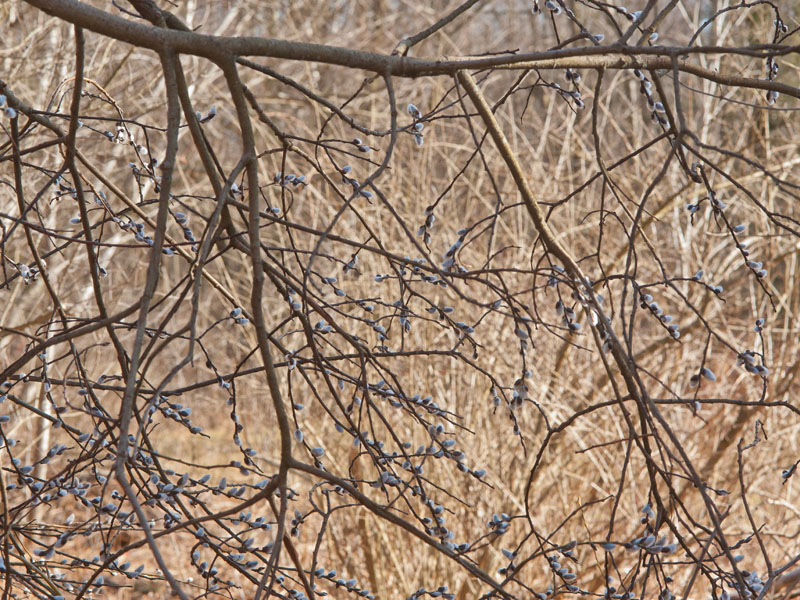
Broken pussy willow tree with spring catkins
The two most abundant shrubs – winterberry and speckled alder – formed dense multi-stemmed thickets that branched out above our heads. Neither species germinates or grows fast. They can take 5 -10 years before first flowering.
My guess is that they got established many years ago, when they still had a chance to get tall before deer devastation became such a problem.
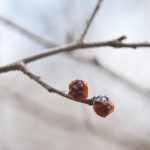
Winterberry holly berry
I was happy to find so many deciduous winterberry hollies (Ilex verticillata), one of my first childhood plant loves. The bark is slashed with knobby white horizontal lenticels that look like sloppy Morse code handwritten around the stems. We found a couple shriveled red berries that the birds hadn’t. (Hollies are dioecious, only female plants produce berries).
Some of the brown-barked saplings with dangling catkins were young birches, others were a puzzle.
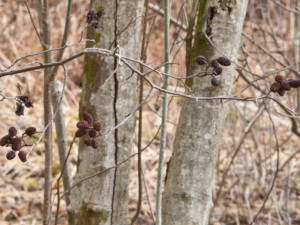
Speckled alder cones
Clusters of hard, dark cones on the same plant as catkins clinched the i.d. Speckled, or grey alder (Alnus incana ssp. rugosa) is monoecious (separate male and female flowers on one plant). The slightly greenish catkins are male flowers. Female flowers produced nutlets inside green cones the previous year; the dried cones remain all winter.
THE LAND SPEAKS
Topography and history held more clues. Water-filled hollows were everywhere. Old overgrown drainage swales diverted some of the water running down the mountainside away from the house and yard.
Paperbark and yellow birch roots seemed to leap out of the ground – a sign of erosion, oxygen-deprived waterlogged soil, shallow topsoil – or all three.
Soil, roots and rocks were entirely carpeted with sphagnum moss, which grows in wet acidic conditions.
I’m guessing it’s not just soppy during spring runoff.
The 18th century owners who built the house and cleared the rest of the land, probably found that section too wet to farm. Thousands of glacially deposited granite rocks remain. To this day, nobody feels compelled to move them.
MORE OBSERVATIONS, CLUES, EDUCATED GUESSES AND RESOURCES
- Lots of sensitive fern spore cases, some lumpy ostrich fern crowns and a couple clumps of green soft rush (Juncus effusus) – they all like it wet.
- The only evergreen is a big old white pine (Pinus strobus) on drier rise, with none of the plants we found in wetter places. It would support a different community of plants. (Now it supports burning bush seedlings planted by roosting birds).
- Evergreens visible in the photo are in the back neighbor’s higher and drier yard. We found haircap moss and Christmas ferns only on the well-drained slope on that back boundary.
- Many plants have very specific soil pH requirements. The Lady Bird Johnson Wildflower Center’s Native Plant Database very helpfully lists the ideal range for each plant. Winterberry prefers acidic soil, below pH 6.8; alder and pussy willows grow best with pH 6.8-7.2.
- There were several mature highbush blueberries – they like acidic soil and moisture too.
- We found one poor shaded-out red-twig dogwood. They take to wet, acidic soil, but need sun. We’ll plant some on the sunny southwest-facing edge. In March/April if you stick pencil-diameter twigs in wet ground, most of them will root in place.
- Pussy willows prefer full sun too – maybe they grew that tall competing for light. Willow twigs readily set roots in wet soil. But it’s fun to root them in water indoors, enjoy them up close, then plant outside.
That’s a lot of hunches for one afternoon.
Soil tests, moisture and pH meters and further research may provide more exact information, fill in the gaps and prove – or disprove – hunches. But for me, it all starts with looking at plants and getting a feel for the site.
A scientist once praised me for writing about plant adaptations without implying that plants have volition. I’m not so sure about that. Plants speak their own truth. If we listen and pay attention, they can tell us where they want to be.
I turned to ecologist Tom Wessel’s Reading the Forested Landscape: A Natural History of New England for deeper understanding.
He explains that, just as in the animal kingdom, there are generalist plant species, and specialists that grow only in particular niche. A plant niche is partially defined by its tolerance ranges, narrowest at the time of germination.
Wessels uses the eastern larch, aka tamarack (Larix laricina), a cold-hardy deciduous conifer common in wet, acidic soils, as an example. It can’t germinate outside its tolerance range in a lawn, but it can grow there if transplanted.
“Because of the germination niche, an eco-indicator is useful to our reading of the landscape only when there is a robust population of that species. One or two individuals should not be used as indicators of site conditions…”
That makes me more comfortable speculating that winterberry, alders and pussy willows are the key indicators for that site. (Willow seeds won’t germinate if they don’t land in wet soil within 24 hours). They’re certainly robust populations. And it explains why native plants we don’t often see in the wild do just fine in our gardens.
What other shrubs might prefer similar conditions? What’s worth a try?
There are generalists that grow in wet or dry soil and aren’t too fussy about pH. But I’m leaning toward specialists that grow naturally in acidic, wet places.
- Larch
- Inkberry holly (Ilex glabra)
- Summersweet (Clethera alnifolia)
- Steeplebush spiraea (Spiraea tomentosa)
- More highbush blueberries
Watch Tom Wessels Reading the Forested Landscape Movie
And watch out for deer sign on the trail – deer will also determine what you plant
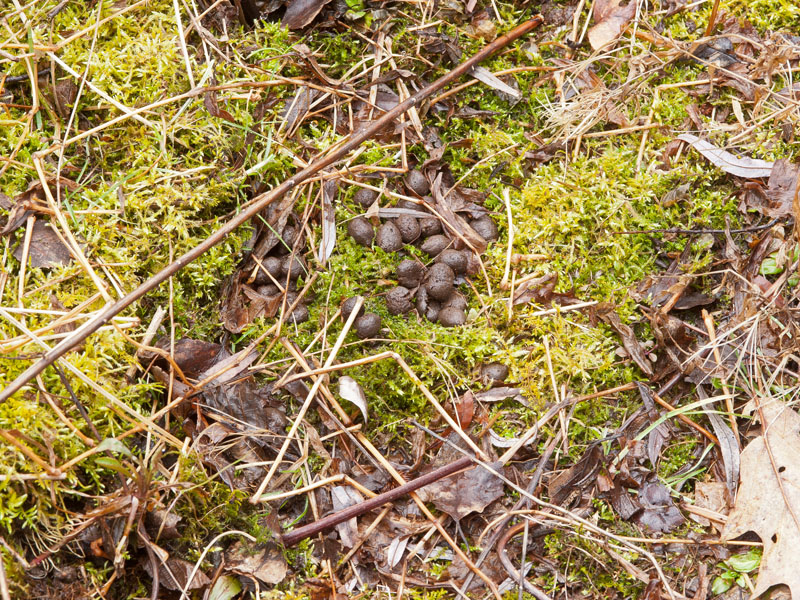
Deer sign on the trail
